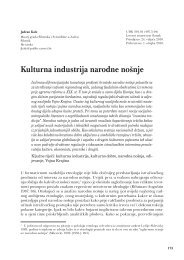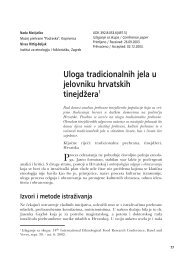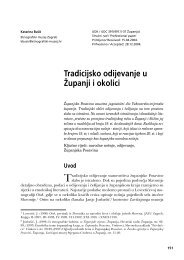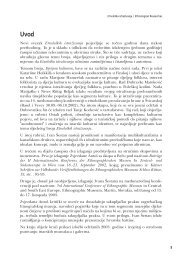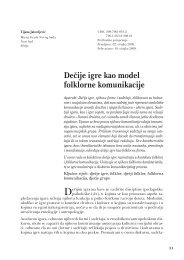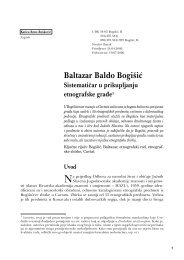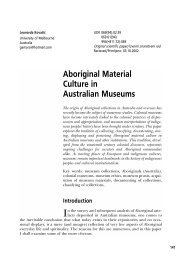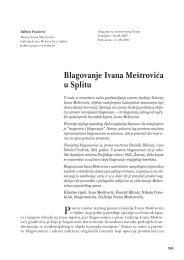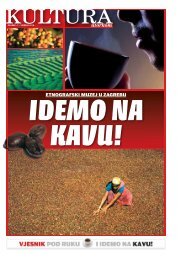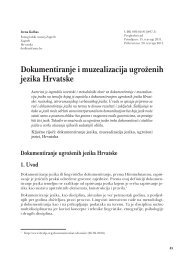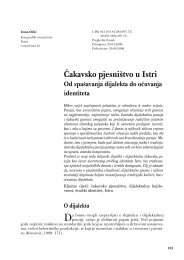Etnoloska istrazivanja / Ethnological researches - EMZ
Etnoloska istrazivanja / Ethnological researches - EMZ
Etnoloska istrazivanja / Ethnological researches - EMZ
You also want an ePaper? Increase the reach of your titles
YUMPU automatically turns print PDFs into web optimized ePapers that Google loves.
Etnološka istraživanja 15/<strong>Ethnological</strong> Researches 15<br />
The second construction<br />
The second construction is even more vague. ‘’Behind the Gradina (the garden of the<br />
lightning-maker) far on the south, on the top Jurin konak (369 m) 10 , the lightningmaker’s<br />
son was sleeping. He had been sleeping before he came to his own father (not<br />
knowing that this one was his father) and got the hand of his sister (not knowing that<br />
she was his sister). Or, he maybe did it after going away from his father from the Gradina<br />
and came here to sleep.’’ (compare Belaj, 2007: 232-233).<br />
It has already been mentioned that on the locality Kremenice-Brežani, not far away to<br />
the Kloštar sanctuary, the remains of the Neolithic, the so called Sopot culture were<br />
found. Neolithic cultures were followed by the cult of the Great Mother. Illyrians, and<br />
later Romans only adjusted the existing sanctuaries to their pantheon. 11 We have the<br />
proof that Romans buried their deceased on the locality of the Kloštar sanctuary. 12<br />
With the arrival of Slavs in this area it is possible that they occupied it and adjusted<br />
it to their religious needs. For now, there are no exact evidence to this claim, which<br />
would tell us about the area and the sanctuary in Kloštar. It is most probable that at<br />
this place the cult of Mother the Great remained, in Slavic culture more famous as<br />
Mokoš. Her name is etymologically connected with the words ‘’moisture, wet’’. She was<br />
the ruler of fertility, water, female affairs and destiny. Worshipping Mokoš, despite the<br />
Christianization in some east Slavic areas, continued to the 16 th century. 13 Numerous<br />
folklore works in the Russian and south Slavic tradition testified to her identification<br />
with Mary, the Blessed Virgin Mary (Belaj, 2007: 381). Therefore, after the baptizing<br />
The Slavs could worship her in the area of Kloštar through the Cristian folk piety as<br />
the Blessed Virgin Mary – the Mother of God. 14<br />
10<br />
In Bosnia, right under the top Jurin konak, towards the top Gradina, we have the toponym for the valley<br />
Crna kaljuga, after that follows the top Kamenita glava (434m), and in the middle towards the top Gradina<br />
is the top Jovanovo brdo (561m).<br />
11<br />
In religious pre-Indoeuropean systems the cult of the Great Mother dominated, or the cult of fertility.<br />
Such a cult also existed in the Illyrian culture. Its different forms went through changes in different Illyrian<br />
areas, but these changes did not significantly change its content. Then, with the arrival of Indoeuropeans<br />
from the Balkans, there comes the solar cult in the Illyrian culture. The deer as a sacrificial animal<br />
is the symbol of the Sun in this area in the Bronze Age already (Stipčević, 1989: 145-149). We find an<br />
argument for this in the nearest, only a couple of kilometres far, mediaval church of St. Demetreus. On<br />
its southern counterfore we have primitively and strictly stylised and in the stone engraved the drawing<br />
of a deer (Gvozdanović, 1972: 216). Hundreds of years-long Roman rule gradually substituted the Illyrian<br />
divinities by the Roman ones. (Stipčević, 1989: 154-157).<br />
12<br />
Semantically matches the connection between the Roman Venus, to whom Friday belonged (Latin dies<br />
Veneris) and the Slavic Mokoš to whom also Friday belonged (in eastern orthodox cult it is St. Petka) (Belaj,<br />
2000: 122).<br />
13<br />
The eastern orthodox source Nomokanon from the 16 th century in which the confessor asks a woman<br />
‘’Have you visited Mokoš?’’ (http://humnauke.blogger.ba/arhiva/2005/03/18#24219, 31/5/2008)<br />
14<br />
Although not easily sustainable and argumented hypothesis that Mokoši’s home was in the area of a<br />
swampy and wet field, maybe somewhere around the area of the toponym Vlaknica, and the sanctuary of<br />
the Blessed Virgin Mary was Veles’s home, the god connected with peasants, peasants’ property, cattle,<br />
diseases and death (comp. Belaj, 2007: 84), there is a possible explanation that over time, when it came<br />
to substitution of their pagan names with the Christian ones, there happened the change of places of Veles<br />
and the Blessed Virgin Mary (Belaj, 2009: 170-171). Then the structure of the mythical occupation of<br />
308



